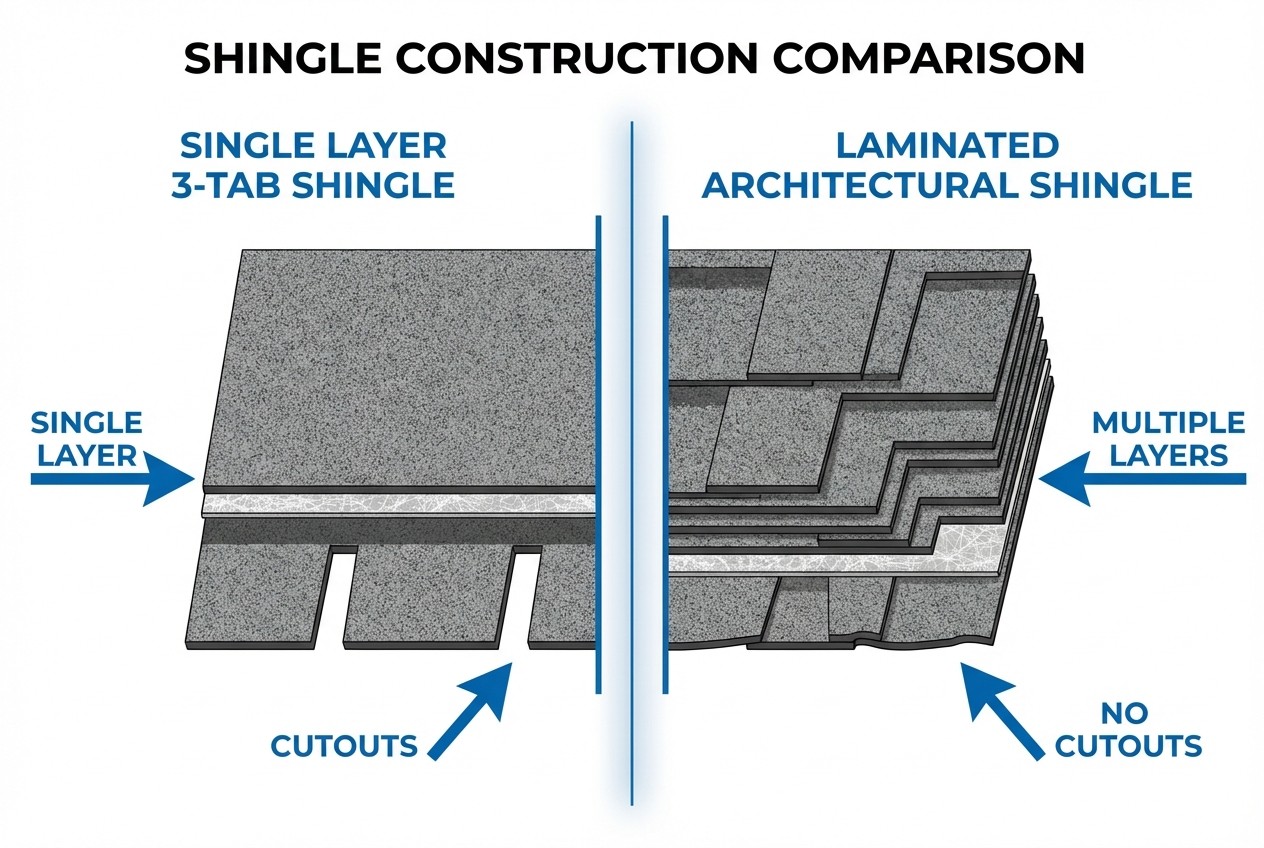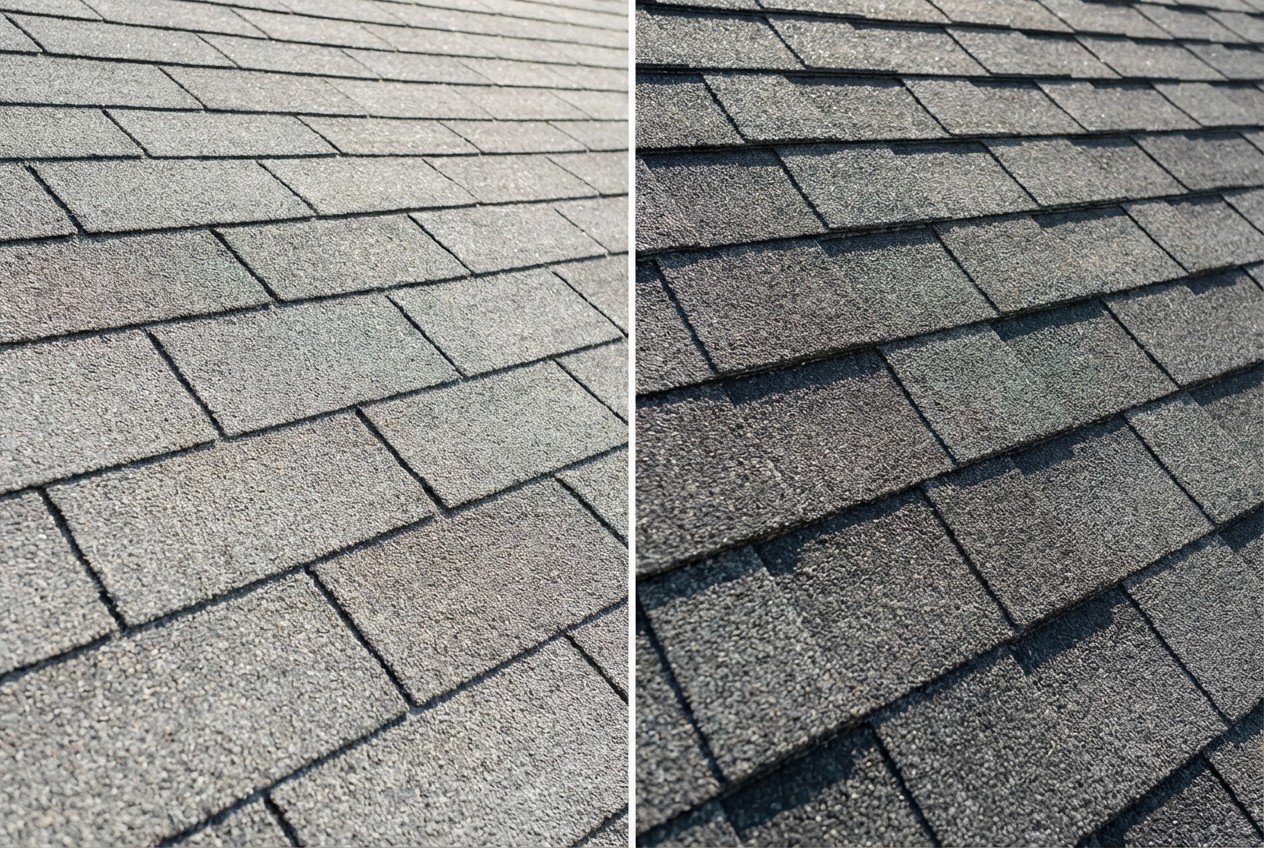For most homeowners, architectural shingles are the better choice; they last longer, resist storms better, and look more attractive. However, 3-tab shingles still make sense if you're on a tight budget or planning to sell soon.
When replacing your roof, one of the first decisions is choosing between 3-tab and architectural shingles. Both are asphalt shingles, but differ in build, appearance, longevity, and cost.
I'll walk you through how these types compare, what each offers, and help you figure out which makes sense for your home and budget.
What Are 3-Tab and Architectural Shingles?
Both are asphalt shingles, made from a fiberglass mat coated with asphalt and topped with ceramic granules. Architectural shingles are thicker and more durable because they're made from multiple layers fused together, while 3-tab shingles are a single flat layer with cutouts.
Because they're thicker, architectural shingles last longer, handle wind better, and create a dimensional look that adds curb appeal—though you'll pay more upfront.
What Are 3-Tab Shingles?
Think of the classic roof style you see on older homes—clean, flat, horizontal lines. That is a 3-tab shingle. They get the name because each long strip is sliced into three distinct tabs. Once installed, they create a very uniform, brick-like pattern across the roof. For decades, 3-tab shingles were the go-to choice, and you'll still see them on roofs today.
What Are Architectural Shingles?
Architectural shingles are also called "dimensional" or "laminated shingles" because they're made by bonding multiple layers of asphalt together. This lamination creates thickness and depth visible from the street.
The extra layers make architectural shingles heavier and more durable. Today, architectural shingles are the most commonly installed type, and most major manufacturers focus primarily on architectural options.
The Difference Between 3-Tab and Architectural Shingle Construction
The construction difference explains how they perform, look, and cost. 3-tab shingles consist of a single layer with cutouts creating the tabs. Architectural shingles have multiple layers laminated together, creating a thicker, heavier shingle with no cutouts.
Why that matters: A typical 3-tab shingle weighs less because it uses less material. Architectural shingles can weigh 50% more due to their multi-layer design, affecting durability and storm handling.

Feature | 3-Tab Shingles | Architectural Shingles |
|---|---|---|
Layers | Single layer | Multiple laminated layers |
Thickness | Thinner, lighter | Thicker, heavier |
Weight | Lighter | Up to 50% heavier |
Cutouts | Yes, creates tabs | No cutouts |
The thicker construction gives architectural shingles an advantage in nearly every performance category. However, added material means a higher price.
What 3-Tab vs Architectural Shingles Look Like

You can tell the difference right away. 3-tab shingles lie perfectly flat against the roof. They create a simple, repeating pattern that looks a bit like a brick wall.
Architectural shingles are thicker. They cast little shadows that give the roof texture and depth. Instead of looking flat, they look like expensive wood shakes or slate.
Most homeowners find architectural shingles significantly improve curb appeal. If planning to sell or wanting your home to look its best, the difference is worth considering.
How Long Do 3-Tab and Architectural Shingles Last?
Architectural shingles last significantly longer due to their thicker, more durable construction. Lifespan depends on climate, installation, ventilation, and maintenance, but architectural shingles typically last 25-30 years compared to 15-20 years for 3-tab.
3-tab shingles are more prone to curling, cracking, and granule loss. The single-layer design provides less material protecting your roof deck. Architectural shingles resist aging issues better because multiple layers provide structural integrity.
This lifespan difference is important when calculating total cost of ownership. A roof that lasts longer means fewer replacements, saving money in the long run even if the initial cost is higher.
Wind Resistance and Durability of 3-Tab vs Architectural Shingles
Architectural shingles outperform 3-tab shingles in wind resistance and durability. The heavier weight and laminated construction help architectural shingles stay in place during storms, while 3-tab shingles are lighter and more susceptible to lifting and blow-off.
This difference is important in Chattanooga, where spring storms and severe weather put your roof through its paces. Architectural shingles also handle hail impacts better; a thicker shingle absorbs impact energy more effectively.
Here's how they compare:
Wind performance: Architectural shingles typically rated for 110-130 mph; 3-tab rated for 60-70 mph
Impact resistance: Thicker construction provides better protection against hail and debris
Damage resistance: Architectural shingles are less prone to curling, cracking, and weathering
If your home is in a storm-prone area or you've dealt with wind damage, the extra durability of architectural shingles provides peace of mind.
3-Tab Shingles vs Architectural Shingles Cost
Architectural shingles cost more upfront, but the price difference is usually more manageable than homeowners think. The gap comes primarily from additional material. However, factoring in longevity and performance, architectural shingles often deliver better value.
Material Cost Differences
Architectural shingles cost more per square because they contain more asphalt and require complex manufacturing. A "square" is the industry standard, equal to 100 square feet.
Material cost typically ranges 20-40% more for architectural shingles. Material costs represent only part of your total investment; labor, disposal, underlayment, and flashing also factor into the final price.
Installed Price Comparison
Labor costs are similar, so the total price difference mainly reflects material cost. A typical roof replacement in Chattanooga might see a difference of $1,500 to $3,500 on an average 1,500-2,000 square foot home.
Getting multiple quotes from local roofers helps you understand what to expect to pay. Prices vary based on pitch, accessibility, and recommended products.
Long-Term Value and Total Cost of Ownership
Here is the reality of the price tag: Architectural shingles are usually cheaper per year, even if they cost more today. Think of it as "cost of ownership." Since they tend to last 10 to 15 years longer than 3-tab options, you aren't paying for a second roof replacement nearly as soon.
There is also the resale factor to consider. Buyers can spot the difference immediately. A new architectural roof looks like a premium upgrade, whereas a new 3-tab roof just looks like basic maintenance. If you want to get the most mileage out of your money, the math almost always favors the upgrade.
Warranty Differences for 3-Tab and Architectural Shingles
Manufacturers offer longer warranties on architectural shingles, reflecting the difference in durability. Architectural warranties often extend decades longer than 3-tab warranties, though specifics vary by manufacturer.
Roofing warranties come in two types: manufacturer warranties covering defects, and workmanship warranties covering installation errors. The manufacturer warranty protects against premature failure due to defects; the workmanship warranty, provided by your contractor, covers installation problems.
When comparing quotes, ask about both. A longer manufacturer warranty on architectural shingles gives added protection, but proper installation matters just as much.
Why 3-Tab Shingles Are Being Discontinued
Over the past decade, most major manufacturers have stopped making 3-tab shingles or cut back on options. The shift happened because demand moved toward architectural shingles, and as they became more affordable, manufacturers focused production on what the market wanted.
Today, you can still find 3-tab shingles, but color and brand options are limited. Some manufacturers have stopped making them entirely.
This is important if considering a partial repair—finding matching 3-tab shingles can be challenging. This might mean replacing a larger section or the entire roof to achieve a uniform appearance.
Which Shingle Type Should You Choose?
For most homeowners, architectural shingles are the right move. The jump in durability and curb appeal usually outweighs the price difference. However, there are still specific situations where sticking with 3-tab makes sense.
When to Stick with 3-Tab
3-tab shingles are still a solid option if the upfront price is your only concern. They make sense if:
You are flipping a house: You need to keep renovation costs low to maximize your profit.
It is a rental property: You want a functional roof without overspending on a premium look.
It is an outbuilding: They are perfect for sheds, barns, or detached garages where aesthetics don't matter as much.
You understand the trade-off: You are okay with a shorter lifespan in exchange for saving money today.
When to Upgrade to Architectural
For most homeowners, the upgrade is a no-brainer. You should choose architectural shingles if:
This is your home: If you plan to live there for a while, the longer lifespan saves you money in the long run.
You live in storm country: The extra thickness acts as a shield against wind and hail damage.
You want curb appeal: They look much better from the street, which boosts your home's value.
You want to avoid repairs: Paying a little more now often prevents storm damage (and insurance deductibles) later.
When Architectural Shingles Are Worth the Investment
Architectural shingles make sense for most homeowners, particularly if:
You're replacing the roof on your primary residence and plan to stay
Your home is in a storm-prone area like Chattanooga where durability matters
You want to maximize curb appeal and home value
You're concerned about wind resistance and weather performance
The upfront cost difference is meaningful, but performance and longevity typically outweigh the initial investment.
How to Compare Roofing Quotes for Different Shingle Types
When gathering quotes, make sure each contractor specifies which shingle type, brand, and product line they're proposing. A quote stating "architectural shingles" isn't detailed enough; you want the manufacturer and model to research specifications, warranty, and wind ratings.
Look for line-item pricing breaking out material costs from labor, disposal, underlayment, and other components. Transparency helps you understand where money is going and makes it easier to compare quotes.
At roofquotes.com, we help homeowners gather multiple vetted quotes with clear line-item pricing so you can compare options side by side. You'll see exactly what each contractor proposes and what you're paying for each component, which takes the guesswork out of choosing between shingle types and contractors.
Get Multiple Quotes to Find the Right Shingles for Your Home
The right choice depends on budget, plans to stay in the home, and what matters regarding appearance and performance. For most, architectural shingles deliver better value, but your situation might differ.
The best way to make an informed decision is comparing real quotes from vetted roofers. You'll see actual pricing, understand recommendations, and feel confident you're making the right choice.
Reach out to us for help finding the right shingle type and manufacturer for your home. We can also help you Get up to 5 vetted quotes from certified roofers and compare line-item pricing in one place. Your money stays protected in escrow until the job is finished and you're completely satisfied.





